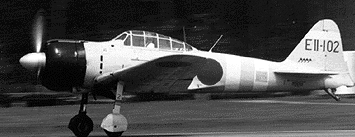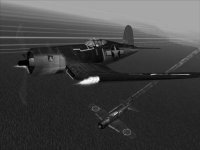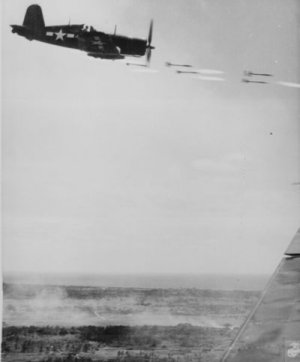|
While
returning to base on the 19th of February 1944, Kepford spotted a
low Japanese seaplane. Although he was alone (his wingman was forced to
abort earlier, and Kepford was retained to cover bombers on-route to
Rabaul), Kepford dived down and flamed the plane. He was then attacked
by a flight of three Zekes, which dived onto him with a massive altitude
advantage. Kepford took full advantage of the newly-installed water
injection WEP to stretch out the chase, but the Zekes' energy advantage
allowed them to slowly narrow the gap. As the lead Zeke opened fire,
Kepford decided to "go for broke." He dropped his flaps and
landing gear and nosed down until he was skimming the waves; as the Zeke
roared over him, he pulled his Hog's nose up and opened fire. The Zeke's
stabilizer crumpled under the snapshot, and the plane crashed into the
waves. As Kepford pulled in his gear and flaps, the remaining two Zekes
bracketed him . . . he was facing 2-to-1 odds, low and slow, and he was
heading back in the direction of Rabaul. Kepford ran his throttle as far
open as possible, and after gaining some speed he cut across the path of
the port Zeke. The Japanese plane dropped to wave top level, opened
fire, and sharply turned to fall onto his six . . . at which point the
Zeke's left wing caught a wave top, and the plane cart wheeled across
the ocean surface, disintegrated, and sank. The third Zeke was left
behind as Kepford dashed for home, landing on fumes in his fuel tank. Kepford
returned to the States in March of 1944, and was assigned to Fleet Air
Command at Alameda, California. In June, he was transferred to VF-84. In
December, he was attached to the Staff of Commander Fleet Air, West
Coast, where he served the remainder of WWII. Kepford retired from the
Navy with the rank of Lieutenant Commander on the 1st of June 1956. In his five months
of combat duty, Ira Kepford scored a total of 16 confirmed kills and 1
unconfirmed. He was awarded the Navy Cross, the Gold Star, the Silver
Star, three Distinguished Flying Crosses, the Air Medal, Unit
Commendation to VF-17, and the American Defence Service Medal.
|



|



